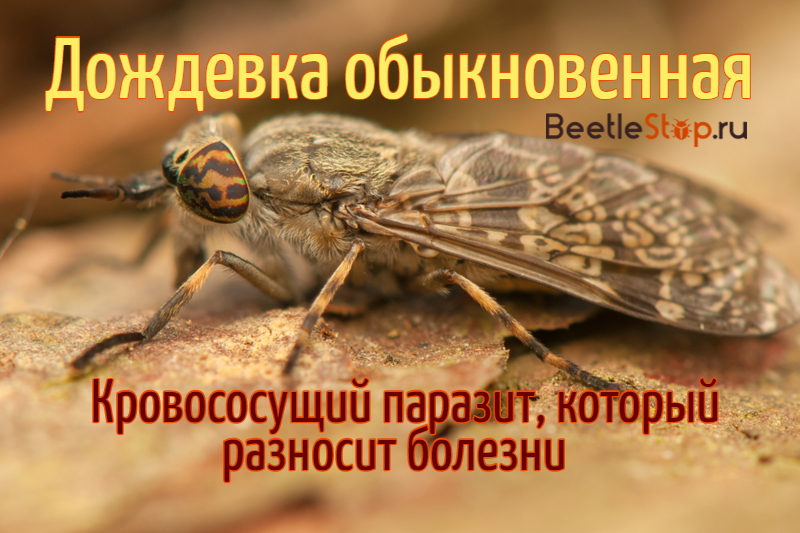Common raincoat - a bloodsucker flying in front of a downpour
Flies are large two-winged insects similar to flies. They are annoying in hot weather, bite animals and drink their blood. One of the many genera of the family is raincoats. Their body size is smaller than other horseflies, their behavior is more careful. Among 400 species, the most common rainshine. The insect attacks animals and people, causing painful bites. The peak of activity falls on the period before the start of precipitation. In areas of distribution, ordinary raincoat belongs to the dominant species. The blood-sucking insect is a carrier of dangerous diseases: tularemia, anthrax.

Morphological description of the species
The common raincoat (Haematopota pluvialis) belongs to the diptera detachment, the horsefly family, the genus of sprinkling or hemorrhage. Flies measuring 9-12 mm are painted with a brownish-gray color. Dark longitudinal stripes on chest. Wings with a characteristic marble pattern of bright spots on a gray background. At rest, they form on the back in the form of a roof. The abdomen is narrow, long, black with side light stripes. The lower body and chest are covered with gray hairs. The limbs are black with yellow rings.
The head connects to the chest with a cervical membrane. Large faceted eyes with colored coloration occupy the entire lateral surface. The stitching-licking oral apparatus in the form of a proboscis is located in the lower part of the head. The antennae are black, short, located between the gases. The first bulb-shaped segment. The third segment is red-yellow. Types of raincoats are distinguished by the color of the antennas.
Information. Raincoats are characterized by sexual dimorphism. Males are distinguished by their appearance - their eyes touch in the frontal part. The organs of vision of the females are separated by the forehead and two simple eyes.
Distribution area
The type of rain gutter is widespread in Europe. Insects live in large numbers in wetlands. They live in the forest zone of Eurasia, in the south of the taiga. The species is found in the north of Kazakhstan, Africa. To the east, bloodsuckers spread to Japan and China. Characteristic for the Caucasus and Western Siberia.
Lifestyle & Reproduction
The time of activity of bloodsuckers is from May to October. Insects fly during daylight hours. Spend a lot of time in the air. They rely on eyesight for food. They do not expect a temperature increase like the rest of horseflies, they go for food at + 16 °. Only females suck blood, males are vegetarians, feed on pollen of plants. Males keep separately, in small groups gather in thickets near water bodies.
For the development of eggs, females need the blood of mammals: horses, cows, goats and other warm-blooded. At one time, the female sucks up to 20 mg of blood. After a few days, the ovipositor begins. During the season, the female is able to make up to 5 clutches of 500-1000 eggs.
Female saturation process
The horsefly proboscis has saber-like parts that cut through the skin. A narrow tongue is penetrated by salivary canals, through which an anticoagulant enters the blood of the victim, which prevents blood clotting. The female plunges the proboscis into the puncture and begins feeding. The duration of feeding is 2-5 minutes. In the process of feeding, the fly reacts poorly to the environment.A substance injected into the blood of animals or humans during a bite adversely affects the state of tissues. It contains toxic components that cause inflammation, itching, and pain.
With numerous attacks, animals lose strength, their health deteriorates. In addition to the obvious harm, raincoats are carriers of dangerous diseases. From their bites, you can get anthrax, tularemia, trypanosomiasis.
Information. When a person bites bloodsucking flies, they choose their hands (especially the wrists) and the trunk.
Breeding
Two-winged insects undergo 4 stages of development: egg, larva, pupa, and imago. Females lay eggs in moist soil on the banks of ponds or among thickets. The eggs have a dense shiny shell. The rows of masonry are glued together by female secretions. embryo development occurs in weeks or drags on for a month. It depends on the weather. Hatching larvae are light, the body is covered with tubercles used for movement. A spindle-shaped body consists of 12 segments, a head with two simple eyes and a hook-shaped upper lip.
They live in moist soil, feed on the remnants of organic matter, prey on the larvae of other insects. In the process of development, 7 ages are replaced. The grown offspring of horseflies remain to winter. Next year, development continues until May-June. Then the larva turns into a chrysalis. Before the adult takes off, the pupa moves to the surface of the soil. A young fly leaves the shell through a gap in the back.

